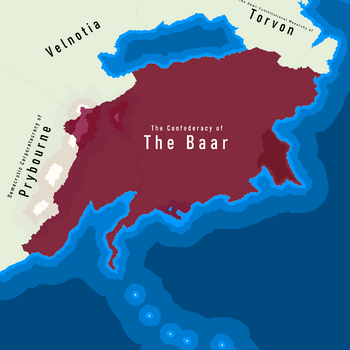The Confederacy of The Baar
The Confederacy of the Baar Het Confederatie von Baar | |
|---|---|
|
Flag | |
| Motto: "Het land von waar vijhed" (The land of true Freedom) | |
| Anthem: "Arbeids, stak!" (Workers, strike!) | |
 The Baar | |
| Location of The Baar in Anteria Location of The Baar in Anteria | |
| Capital and | The Baar |
| Official languages | Baarian, Dutch, English |
| Recognised national languages | Baarian |
| Recognised regional languages | Wouds |
| Ethnic groups (February 2021) | Baar (63%) Moer (17%) Woud (7%) Other (13%) |
| Demonym(s) | Baarian/Baar |
| Government | Federal left-wing Minarchist Repbulic |
• President of the Cantons Council | Gilbert Leonard |
• Head of the National Council | Magdalena Thomas |
| Legislature | Federal Assembly |
| Cantons Council | |
| National Council | |
| History WIP | |
| Currency | Scudo |
| Time zone | UTC-7:00 (CBT) |
| Date format | dd/mm/yyyy |
| Driving side | right |
| Calling code | +34 |
| ISO 3166 code | BA |
The Baar (Baarian/Dutch: Het Baar), officially the Confederacy of the Baar, is a country located in the southwestern part of the continent of Thuadia, in Anteria. It is bordered by Torvon to the Northeast, Prybourne to the West, and Velnotia to the Northwest, and has coastline to the Hagalaz Ocean to the south, and to the Reševalec/Verlosser to the north.
The country was created in 1732 as a union between the multiple cantons. It has since become one of the countries with the highest civil rights.
It has recieved a lot of tourism lately, and has been considered by many as a tax haven. Cannabis is legal.
Etymology
One theory suggests that the name "Baar" may come from the Dutch word "baat" (English: benefit, advantage) talking about the prosperous lands. Some people have suggested that it comes from the dutch "baan" (English: job, track) talking about the wave of immigrants searching jobs, but that happened in the 60's, when the name had already been used for a long time.
History
The Paleolithic and the Paleo-Anterians
Humans are thought to have first reached the lands of the Baar around 50,000 BCE. Not many Paleo-Anterian skeletons or caves remain or have been found. They started using Stone Tools around the year 35,000 BCE.
